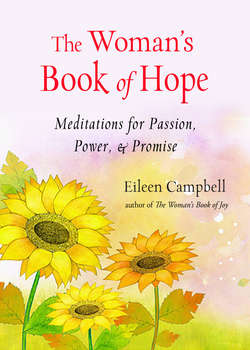Читать книгу The Woman's Book of Hope - Eileen Campbell - Страница 13
На сайте Литреса книга снята с продажи.
7. Letting our creativity blossom
ОглавлениеIf we want to change our lives and create a future that's better than the situation we're currently experiencing, then we need to use our imagination to the full. Pir Vilyat Khan, the much-loved Sufi teacher, wrote: “The future is not there waiting for us. We create it by the power of the imagination.”
We're all capable of accessing our imagination; it's just that as adults we don't necessarily employ it as easily as we did when we were children. We were more open and receptive then, but becoming adults meant that as we learned the ways of our left-brain-dominated culture, we probably became more closed down and inhibited.
Imagination is such a powerful tool when we give it free rein. It is connected with the life force, the source of all creativity, and we need to turn inward to find this so that inspiration floods in and increases our hope for what is possible. Instead of being perpetually drawn outward by all the distractions of modern life, if we pay attention to our inner world, we can more easily access imagination and picture (literally) new vistas and new ways of being. What we imagine, we can create, and the vision we create on the mental level, giving us a sense of purpose born of hope, can spur us on in our darkest moments.
Patanjali, the great exponent of yoga writing in the second century BC, understood the process:
When you are inspired by some great purpose, some extraordinary project, all your thoughts break their bonds; your mind transcends limitations, your consciousness expands in every direction, and you find yourself in a new, great and wonderful world.
One of America's greatest poets, Emily Dickinson, had a rich interior life and lived in a world with far less stimulation than ours. Hers was a life of simplicity and seclusion in the family home in nineteenth-century Amherst, Massachusetts. “To live is so startling, it leaves little room for other occupations,” she claimed. Along with the almost eighteen hundred poems she wrote, her life comprised baking, gardening, attending church, painting, reading books, playing the piano and singing, and taking walks. She shared her poems mainly with family and friends and was barely published in her lifetime. We know from both her poems and her letters that she suffered tragic losses among her family and friends, and she wrote about the nature of death and immortality with great power and insight. Unorthodox and independent in her views on religion, Emily drew inspiration from the beauty of nature and her experiences of ecstatic joy. She well understood the nature of hope, expressed in her famous lines:
Hope is the thing with feathers
That perches in the soul
And sings the tune without the words
And never stops at all.
We too can be in touch with our inner world and let our creativity blossom. When we're hopeful and open to receiving inspiration, our imagination is fired, ideas seem to come to us out of the blue, and we feel joyful and alive. We're affirming our creative nature and can put our energy into making the future brighter.
I turn inward to access the power of my imagination.
I am putting my creative energy into making the future brighter.
I find myself in a new and wonderful world.
